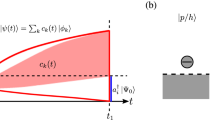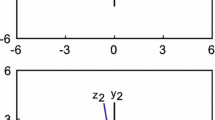Summary
We postulate that only linear systems are basic,i.e. irreducible. Any nonlinear system may be resolved into constituent systems such that ultimately only basic interacting linear systems are obtained. TheS-matrix analysis of quantum electrodynamics is formally equivalent to special instances of Duffing's equation. These special instances describe interacting systems of the three-body kind. Three-body interaction is a parametric excitation, in which each of the interacting systems is describle by a wave amplitude equation. Each wave amplitude equation can be related deterministically to quantum theory. The coupling of linear systems may be either continuous or discontinuous. The Klauder phenomenon is an example of discontinuous coupling. Nonrenormalizable field phenomena may be explained as due to the existence of a singularity in the relation of the wave amplitude equation and the exponential peerturbation. The two types of system coupling-continuous and discontinuous-give rise to two separate types of nonlinear transduction. The first is based on the activity of the harmonic oscillator and its theoretically identical to the white-noise analysis. The second is based on the activity of the harmonie oscillator parametrically excited to anharmonicity and is theoretically identical to the shot noise analysis. Together, the two types of system analysis provide a general theory of nonlinear phenomena.
Riassunto
Si postula che solo sistemi lineari sono basici, cioè irriducibili. Qualsiasi sistema non lineare può essere risolto in sistemi costituenti tali che alla fine si ottengono solo sistemi lineari di base interagenti. L'analisi della matriceS dell'elettrodinamica quantica è formalmente equivalente ad esempi speciali dell'equazione di Duffing. Questi speciali esempi descrivono sistemi interagenti, del tipo a tre corpi. L'interazione a tre corpi è un'eccitazione parametrica, nella quale ciascuno dei sistemi interagenti è descrivibile da un'equazione d'ampiezza d'onda. Ciascuna equazione d'ampiezza d'onda può essere messa in relazione deterministicamente con la teoria quantistica. L'accoppiamento di sistemi lineari può essere sia continuo che discontinuo. Il fenomeno di Klauder è un esempio di accoppiamento discontinuo. Fenomeni di campo non rinormalizzabili possono essere spiegati come dovuti all'esistenza di una singolarità nella relazione dell'equazione d'ampiezza d'onda e nella perturbazione esponenziale. I due tipi di accoppiamento di sistemi-continuo e discontinuo-danno origine a due tipi separati di trasduzione non lineare. Il primo è basato sull'attività dell'oscillatore armonico, ed è teoricamente identico all'analisi del rumore bianco. Il secondo è basato sull'attività dell'oscillatore armonico eccitato parametricamente ad anarmonicità, ed è teoricamente identico all'analisi del rumore da proiettile. Insieme i due tipi dianalisi del sistema forniscono una teoria generale per fenomeni non lineari.
Резюме
Мы постулируем что только линейные системы являются ба зисными, т.е. неприводимыми. Любая нелинейная система может быть разложена на составные части так, что в конечном счете получаются базисные взаимодействующие линейные системы. АнализS-матрицы квантовой электродинамики формально эквивалентен специальным слрчаям уравнения диффинга. Эти специальные случаи описываьт взаимодействуьщие системы трехчастичного типа. Трехчастичное взаимодействие представляет параметрическое возбуждение, в котором каждая из взаимодействующих систем описывается уравнением для амплитуды волны. Каждое уравнение для амплитуды волны может быть связано с квантовой теорией. Связь линейных систем может быть либо непрерывной, либо дискретной. Явление Клаудера представляет пример дискретной связи. Явления непереноммируемых полей могут быть объяснены существовием синтулярности в соотношении, связывающем уравнение для амплитуды волны и экспоненциальное возмущение. Два типа связи систем-непрерывная и дискретная-приводят к двум различным типам нелинейной трансдукции. Первый тип основан на активности гармонического осциллятора и терретически тождественен анализу белого шума. Второй тип основан на активности гармоническто осциллятора, параметрически возбужденного до ангармоничности, и теоретически тождественен анализу флуктуационного шума. Вместе, анализ систем двух типов дает общую теорию нелинейных явлений.
Similar content being viewed by others
References
T. W. Barrett:Journ. Nonlinear Analysis, Theory, Methods and Applications,1, 443 (1977).
R. Thom:Structural Stability and Morphogenesis (Reading, Mass., 1975).
T. W. Barrett:Nuovo Cimento,45 B, 297 (1978).
P. J. Holmes andD. A. Rand:Journ. Sound Vibr.,44, 237 (1976).
C. Hayashi:Nonlinear Oscillations in Physical Systems (New York, N. Y., 1964);W. T. Thompson:Vibration Theory and Applications (London, 1966);S. Timoshenko andD. H. Young:Vibration Problems in Engineering, 3rd Edition (New York, N. Y., 1955).
J. Schwinger:Proc. Nat. Acad. Sci. U.S.A.,44, 956 (1958).
E. R. Benton:Handbook of Applied Mathematics, edited byC. E. Pearson (New York, N. Y., 1974), p. 271.
J. R. Klauder:Phys. Lett.,47 B, 523 (1973);56 B, 93 (1975);Science,199, 735 (1978);B. Simon:Journ. Functional Analysis,14, 295 (1973).
L. C. Detwiler andJ. R. Klauder:Phys. Rev. D,11, 1436 (1975).
B. DeFacio andC. L. Hammer:Journ. Math. Phys.,15, 1071 (1974).
H. Ezawa, J. R. Klauder andL. A. Shepp:Ann. of Phys.,88, 588 (1974);Journ. Math. Phys.,16, 783 (1975).
R. P. Feynman andA. R. Hibbs:Quantum Mechanics and Path Integrals (New York, N. Y., 1965).
J. R. Klauder:Phys. Lett.,47 B, 523 (1973).
J. R. Klauder:Phys. Lett.,56 B, 93 (1975).
J. R. Klauder:Science,199, 735 (1978).
G. Feinberg andA. Pais:Phys. Rev.,131, 2724 (1963);133, B 477 (1964);M. N. Khuri andA. Paris:Rev. Mod. Phys.,36, 590 (1964);K. Symanzik:Comm. Math. Phys.,45, 79 (1975).
T. W. Barrett:Adv. Biol. Med. Phys., in press.
Author information
Authors and Affiliations
Additional information
To speed up publication, the author of this paper has agreed to not receive the proofs for correction.
Traduzione a cura della Redazione.
Перевебено ребакцией.
Rights and permissions
About this article
Cite this article
Barrett, T.W. TheS-matrix analysis of quantum electrodynamics as three-body interaction and an interpretation of the Klauder phenomenon. Nuov Cim B 52, 45–55 (1979). https://doi.org/10.1007/BF02743568
Received:
Published:
Issue Date:
DOI: https://doi.org/10.1007/BF02743568




